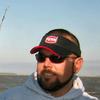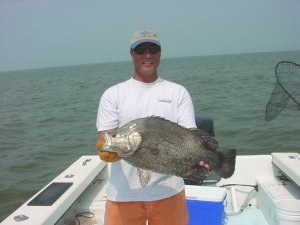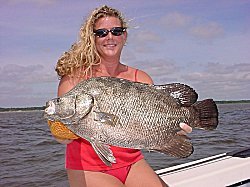Sight casting for TripleTail may possibly be one of the most exciting angling experiences on the water.
Many of us have seen TripleTail, but simply didn't know what it was when we motored right by the fish and spooked it, or thought it was trash floating beneath the surface.
The best way to describe what to look for when watching for a TripleTail is seeking out a brown paper bag floating an inch or two beneath the ocean surface. As you approach, it will appear to be an old ugly, brown dead fish with three tails floating out to sea with the tide. Not the case. He is very much alive, lying there waiting in a meal to pass by his nose.
If you motor up too close, the fish will bolt to the bottom leaving a hole in the water the size of a #4 wash tub if he is good sized.
TripleTail range from 1 30 pounds and their table quality is out of this world. They are one of my favorite fish tocatch and "hunt". This sport is a lot like Turkey hunting. Turkey hunters seem to enjoy this sport more than the average angler as the thrill of the hunt is more than a rush, it's a passion.
"Sunlight & Sighting Triple Tail"
If you decide to do some serious TripleTail Angling, you should be aware of several key factors. Sunlight, as simple as it may sound, plays a major role in spotting these fish as targets for sight casting in dirty water areas like St. Simons Island and the Georgia Inshore waters overall.
As High Noon approaches during late April through August, you should be idling away from the dock wearing your favorite pair of polarized glasses.
The High Noon light allows you to see more than just one direction when you are in search of TripleTail. Glare is your enemy with this sport as it hindersnearly allsubsurface vision no matter what your brand of glassses. Most of the time in dirty water, those fish are just below the surface with no backs out of the water. Now and then you'll see a TripleTail with its back up an inch or so, but the norm will bebelow thesurface about 6-12 inches or deeper.
"A word on Bait and Flies for Triple
Tail"
As a light tackle spinning enthusiast, I personally prefer a live shrimpand my second choice would be aGULP Molten3" Shrimp.After all,what doesn't eat a live shrimp in the Atlantic Ocean? These fish love a big; thumping live shrimp presented right to its face.
An old charter fishing guide andfriend of mine, Capt. Greg Smith, has had many years of success on TripleTail using a small fillet of menhaden with a small portion of the tail still attached. It shouldsimplylook like a strip bait with a tail. This is an excellent choice if you have no shrimp and you're a bait fisherman.
Another close friend of mine,Capt. Teddy Elrodis an extremely talented fly fisherman. He has caught moretriple tailon flies thanmany anglers have caught on conventional tackle. He suggests that a fly angler be extremely cautious in the presentation and work the fly extremely slow in front of the fish to avoid a "No Take" resulting in a recast(s), and possibly spooking the fish.
For the fly fishing angler, we suggest building your fly to imitate a shrimp and maybe even use a crab pattern. A green and white streamer works the best, though. Of course, any pattern you choose will need to be prepared with floating line.
On light wind days, a 6 or 7 weight rod will work fine. When the wind picks up as it always does in the afternoon, a 7 or 8 weight rod will get the fly into position a bit easier.
"The Light Tackle Triple Tail Rig"
Believe it or not, this can be some serious and extreme light tackle angling. The larger triple tailwillpull off a pile of line when usinglight tackle withfast tipped rods. My choice on tackle is an Ugly StikLite Inshore8-15 pound classRod;Penn Sargus(30) Spinning reel filled to the brim with 15-pound braided line.
Attach a 4 ft. section of 15 pound Fluorocarbon leader with a blood knot, or whatever your favorite knot may be. Just don't use a swivel.
Another HUGE tip for Triple tail fishing is the float. A small, "Pin On", weighted Crappie or Bream float works wonders. The smaller your float is, the better your results will be. Most of these floats are available in 2 colors, yellow and orange. Whichever you choose is irrelevant.
When you purchase your floats, grab a roll of black electrical tape while you're out. Wrap those floats from head to toe with black tape. I have found these fish will sometimes hit the float instead of the bait in confusion. You don't have to worry about that once you have taped it black. They'll go for the bait instead of the float.
Float position on your leader is equally important. Attach your float about 6 inches above your hook so the fish doesn't have to work too hard to get to down on the bait. God forbid we should make that fish have to think about what to do. You want the bait or fly to drift in front of his face, literally.
Finally, finish off your rig with a #2Kahle or lazer sharp straight hook. Don't leave much tag sticking out of your knot to "tickle" the fish as he begins to sample your offering.
These fish are extremely powerful, so when you do get one to sink the float, you will be absolutely amazed at the power of the illusive "Saltwater Bream". Fishing with about 3 pounds of drag and15 pound line will have you chasing one with the boat to recover your line as he peels it down to the spool in a hurry!
"When & Where to Fish for
TripleTail"
Tripletail are plentiful in most areas from April right on through the summer season. This holds true for the Gulf or Atlantic.
One thing is for certain, Tripletail don't require deep water to feed. They can be sighted in Sounds and Nearshore of the Beaches on the S.E. or S.W. seaboard in 5 to 50 ft. of water. In southern Florida, they are found commonly in the Gulf Stream floating with weed patches and around other structures.
If you have an outgoing tidal situation, start offshore off the beaches or Sounds and work slowly Inshore in a zigzag pattern until you locate one. Do just the opposite on an incoming tide. Once you spotthefirst Triple Tail, work that general area and chances are, you will find more just acres away. Work tide lines and temperature breaks, too. These areas are notorious for holding TripleTail.
The fish will begin to show themselves when the water temp. reaches 65 degrees and it will only get better as it rises into the 70's. The prime temperature seems to be mid 70's to 80 degrees.
Be Careful, it's a highly addictive sport, especially when you find that fish that looks like a trash can lid floating, your heart will pound and your trigger fingerdoesn't work righton that first cast alot of times.
Boat Position and presentation for
Triple Tail
There are many theories on how to present your offering and positioning your boat to do so. I have found the best way is to approach the fish bow first, of course, but with your stern to the wind and the helmsman can hold with the engine(s) in Reverse as the wind blows you closer to the target. They will spook, but not very easily. You'll be surprised how close you can get to these fish as you acquire a feel for the sport.
Cast your fly or bait past the fish and strip or reel it back about a foot or so in front of him. Be patitent as he samples the offering. Normally, he will be more than glad to take it. Just hold still and wait. He will eventually explode on the fly or down the float with authority.
Aword on Handling Triple Tail
TripleTail have huge razor like plates on their gills. Bring along a large dip net to land these fish and handle them with care and look out for that gill and ALWAYS use gloves on at least on hand.
Happy Fishing!
Capt. Richie Lott - http://www.richielottoutdoors.com




